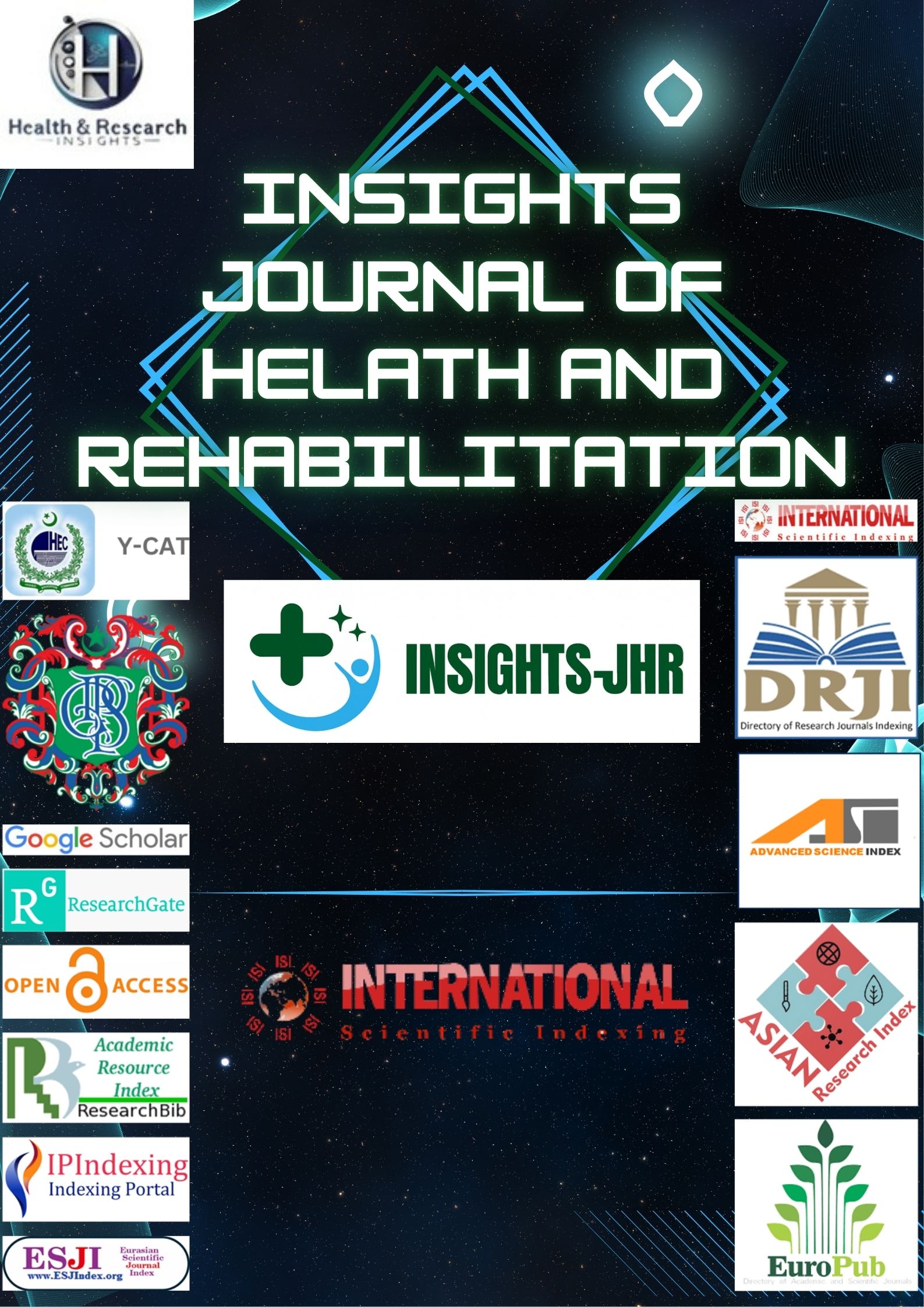PREVALENCE OF DE-QUERVAIN’S SYNDROME IN MOBILE GAMERS AMONG THE GENERAL POPULATION WITHIN DIFFERENT CITIES OF PAKISTAN
DOI:
https://doi.org/10.71000/gfg52h26Keywords:
De-Quervain’s syndrome, Mobile phone, Pakistan, ergonomics, gaming, hand, wrist painAbstract
Background: De Quervain’s Syndrome (DS) is a common form of tenosynovitis involving the tendons of the wrist and thumb, frequently resulting from repetitive strain. With the global rise in mobile phone use, and mobile gaming in particular, concerns have increased about its musculoskeletal impact on young populations. Prolonged gaming sessions requiring repetitive thumb and wrist movements place individuals at greater risk of developing DS. Understanding its prevalence among mobile gamers in Pakistan provides valuable insight for preventive strategies and health promotion.
Objective: The study aimed to determine the prevalence of De Quervain’s Syndrome and its association with mobile gaming in the general population of Pakistan.
Methods: An analytical cross-sectional study was conducted over six months, enrolling 500 participants aged 15–40 years from Islamabad, Rawalpindi, Quetta, Karachi, Peshawar, and Gilgit through non-probability convenience sampling. The presence of DS was clinically assessed using Finkelstein’s test, while pain severity and functional impairment were evaluated using the Patient-Rated Wrist and Hand Evaluation (PRWHE) questionnaire. Sample size was calculated using Rao-Soft software, and all data were analyzed with IBM SPSS version 21.
Results: Of the 500 participants, 310 (62%) were females and 190 (38%) males, with a mean age of 22.36 ± 4.38 years. Mobile gaming was reported by 394 (78.8%) participants. Among gamers, 301 (76.4%) tested positive on Finkelstein’s test for DS compared to 33 (31.1%) among non-gamers. Symptom severity among gamers was distributed as 15% with no symptoms, 28.7% minimal, 36.3% mild, 17.3% moderate, and 2.8% severe. A significant association was established between gaming and DS (p < 0.001), with a correlation coefficient of 0.393, indicating a moderate positive relationship.
Conclusion: De Quervain’s Syndrome was highly prevalent among mobile gamers, demonstrating a strong association with gaming behaviors. The findings highlight the importance of ergonomic guidelines, awareness programs, and preventive measures to reduce musculoskeletal risks in frequent mobile phone users.
References
Bonczar M, Walocha J, Pasternak A, Depukat P, Dziedzic M, Ostrowski P, et al. Anatomical variations in the first dorsal compartment of the wrist: meta-analysis. Folia Morphol (Warsz). 2023;82(4):766-76.
Liu C, Moye S, Blazar P, Earp BE, Zhang D. Anatomical Variations of the First Dorsal Compartment in de Quervain Tenosynovitis. Hand (N Y). 2024;19(7):1159-65.
Ton DA, den Hollander NK, van Steenbergen HW, van der Helm-van Mil AHM. Comparison of findings on contrast-enhanced MRI of the hand, wrist, and forefoot in healthy controls, two at-risk groups, and patients with rheumatoid arthritis: a cohort study. Lancet Rheumatol. 2025;7(9):e618-e28.
Ledoux P. De Quervain's tendinitis after trapeziometacarpal arthroplasty. Hand Surg Rehabil. 2024;43(4):101737.
Keidan T, Saleh S, Svorai Band S, Gannot G, Oron A. [DE QUERVAIN'S TENOSYNOVITIS - CLINICAL PRESENTATION AND TREATMENT]. Harefuah. 2022;161(11):706-8.
Siddiq MAB. de Quervain's Tenosynovitis with Accessory Abductor Pollicis Longus Tendon and 'Wartenberg's syndrome' - A Case Report. Curr Rheumatol Rev. 2023;19(2):230-4.
Hartveld L, Smittenberg MN, Keuter XHA. [De Quervain's tenosynovitis: Clinical aspects and diagnostic techniques]. Ned Tijdschr Geneeskd. 2021;165.
Mandiroglu S, Alemdaroglu E. Idiopathic carpal tunnel syndrome and de Quervain's tenosynovitis: is there an association? Somatosens Mot Res. 2021;38(4):353-6.
Ahmed AF, Rayyan R, Zikria BA, Salameh M. Lateral epicondylitis of the elbow: an up-to-date review of management. Eur J Orthop Surg Traumatol. 2023;33(2):201-6.
Gannot G, Saleh S, Fuchs L, Oron A. Neglected congenital trigger thumb. Hand Surg Rehabil. 2022;41(3):415-7.
Kamray R, Shabbir H, Nouman T, Fatima M, Khan K, Asim HA, Ali A. Comparative Effectiveness of Motor Imagery Training Versus Conventional Strength Training on Quadriceps Strength, Pain Levels, and Range of Motion in Patients Six Months Post-ACL Reconstruction: A Randomized Controlled Trial. Journal of Health, Wellness and Community Research. 2025 Jul 11:e529-.
Zimmerman M, Nilsson P, Rydberg M, Dahlin L. Risk of hand and forearm conditions due to vibrating hand-held tools exposure: a retrospective cohort study from Sweden. BMJ Open. 2024;14(6):e080777.
Gessl I, Vinatzer A, Supp G, Zauner M, Durechova M, Lechner L, et al. Tendon involvement and its association with pain and hand function in patients with osteoarthritis of the hand. Rheumatology (Oxford). 2025;64(4):1775-82.
Schmitt R, Hesse N, Grunz JP. Tendons and Tendon Sheaths of the Hand - An Update on MRI. Rofo. 2022;194(12):1307-21.
Iordache SD, Frenkel Rutenberg T, Pizem Y, Ravid A, Firsteter O. Traditional Physiotherapy vs. Fascial Manipulation for the Treatment of Trigger Finger: A Randomized Pilot Study. Isr Med Assoc J. 2023;25(4):286-91.
Lee YK. Treatment of subacute/chronic ECU tendinopathy using wrist arthroscopy and open surgical repair. J Orthop Surg (Hong Kong). 2022;30(1):23094990211067009.
Giri SK, Suba S, Bandyopadhyay A, R P. Tuberculous flexor tenosynovitis of wrist and hand. BMJ Case Rep. 2023;16(3).
Lv Z, Yang Y, Bao Y, Deng C. Unveiling the genetic association between rheumatoid arthritis and four common hand pathologies. Eur J Med Res. 2025;30(1):492.
Ali S, Anwar I. iMedPub Journals Incidence of De Quervain ’ s Tenosynovitis in Layba Awais 1 ,. 2020;1–4.
Hassan K, Shabbir H, Nouman T, Azfar H, Bano S, Ali A, Asim HA. Comparative Efficacy of Low-Level Laser Therapy and Platelet-Rich Plasma Injection on Pain, Tendon Thickness, and Functional Outcomes in Athletes with Patellar Tendinopathy: A 12-Week Randomized Controlled Trial. Journal of Health, Wellness and Community Research. 2025 Jul 11:e530-.
Baabdullah A, Bokhary D, Kabli Y, Saggaf O, Daiwali M, Hamdi A. The association between smartphone addiction and thumb/wrist pain: A cross-sectional study. Med (United States). 2020;99(10):E19124.
Amjad F, Farooq MN, Batool R, Irshad A. Frequency of wrist pain and its associated risk factors in students using mobile phones. Pakistan J Med Sci. 2020;36(4):746–9.
Downloads
Published
Issue
Section
License
Copyright (c) 2025 Nemra Shah, Muhammad Mustafa, Azka Batool, Saleem Shezad, Muhammad Affan Iqbal, Ayesha Khalid, Afia Ashgar (Author)

This work is licensed under a Creative Commons Attribution-NonCommercial-NoDerivatives 4.0 International License.







